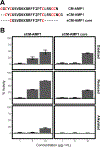The Greater Celandine: Identification and Characterization of an Antimicrobial Peptide from Chelidonium majus
- PMID: 38366995
- PMCID: PMC10959680
- DOI: 10.1021/acs.jnatprod.3c00939
The Greater Celandine: Identification and Characterization of an Antimicrobial Peptide from Chelidonium majus
Abstract
Chelidonium majus, known as Greater Celandine, is a latex-bearing plant that has been leveraged for its anticancer and antimicrobial properties. Herein, C. majus aerial tissue is mined for the presence of antimicrobial peptides. A highly abundant cysteine-rich peptide with a length of 25 amino acids, deemed CM-AMP1, is characterized through multiple mass spectrometric approaches. Electron-activated dissociation is leveraged to differentiate between isoleucine and leucine residues and complement conventional collision-induced dissociation to gain full sequence coverage of the full-length peptide. CM-AMP1 shares little sequence similarity with any proteins in publicly available databases, highlighting the novelty of its cysteine landscape and core motif. The presence of three disulfide bonds in the native peptide confers proteolytic stability, and antimicrobial activity is greatly decreased upon the alkylation of the cysteine residues. Synthetic variants of CM-AMP1 are used to confirm the activity of the full-length sequence and the core motif. To assess the biological impact, E. coli was grown in a sublethal concentration of CM-AMP1 and quantitative proteomics was used to identify proteins produced by the bacteria under stress, ultimately suggesting a membrane lytic antimicrobial mechanism of action. This study integrates multiple analytical methods for molecular and biological characterization of a unique antimicrobial peptide identified from C. majus.
Figures






Similar articles
-
Combination of transcriptomic and proteomic approaches helps to unravel the protein composition of Chelidonium majus L. milky sap.Planta. 2016 Nov;244(5):1055-1064. doi: 10.1007/s00425-016-2566-7. Epub 2016 Jul 11. Planta. 2016. PMID: 27401454 Free PMC article.
-
Proteomic comparison of Chelidonium majus L. latex in different phases of plant development.Plant Physiol Biochem. 2017 Mar;112:312-325. doi: 10.1016/j.plaphy.2017.01.010. Epub 2017 Jan 13. Plant Physiol Biochem. 2017. PMID: 28131060
-
Evaluation of the in vitro and in vivo antimicrobial activity of alkaloids prepared from Chelidonium majus L. using MRSA- infected C. elegans as a model host.Fitoterapia. 2024 Jun;175:105944. doi: 10.1016/j.fitote.2024.105944. Epub 2024 Apr 4. Fitoterapia. 2024. PMID: 38580033
-
Hepatotoxicity induced by greater celandine (Chelidonium majus L.): a review of the literature.Eur Rev Med Pharmacol Sci. 2017 Mar;21(1 Suppl):46-52. Eur Rev Med Pharmacol Sci. 2017. PMID: 28379595 Review.
-
Chelidonium majus--an integrative review: traditional knowledge versus modern findings.Forsch Komplementmed. 2010 Oct;17(5):241-8. doi: 10.1159/000321397. Epub 2010 Oct 8. Forsch Komplementmed. 2010. PMID: 20980763 Review.
Cited by
-
Identification of Novel Antimicrobial 2‑(Pyrimidin-2-yl)-5-alkyl-pyridazin-3(2H)‑one Scaffolds against , Inspired by Luffariellolide.ACS Omega. 2025 Jul 22;10(30):33704-33711. doi: 10.1021/acsomega.5c04559. eCollection 2025 Aug 5. ACS Omega. 2025. PMID: 40787354 Free PMC article.
References
-
- Zhang LJ; Gallo RL, Antimicrobial peptides. Curr Biol 2016, 26 (1), R14–9. - PubMed
Publication types
MeSH terms
Substances
Grants and funding
LinkOut - more resources
Full Text Sources

